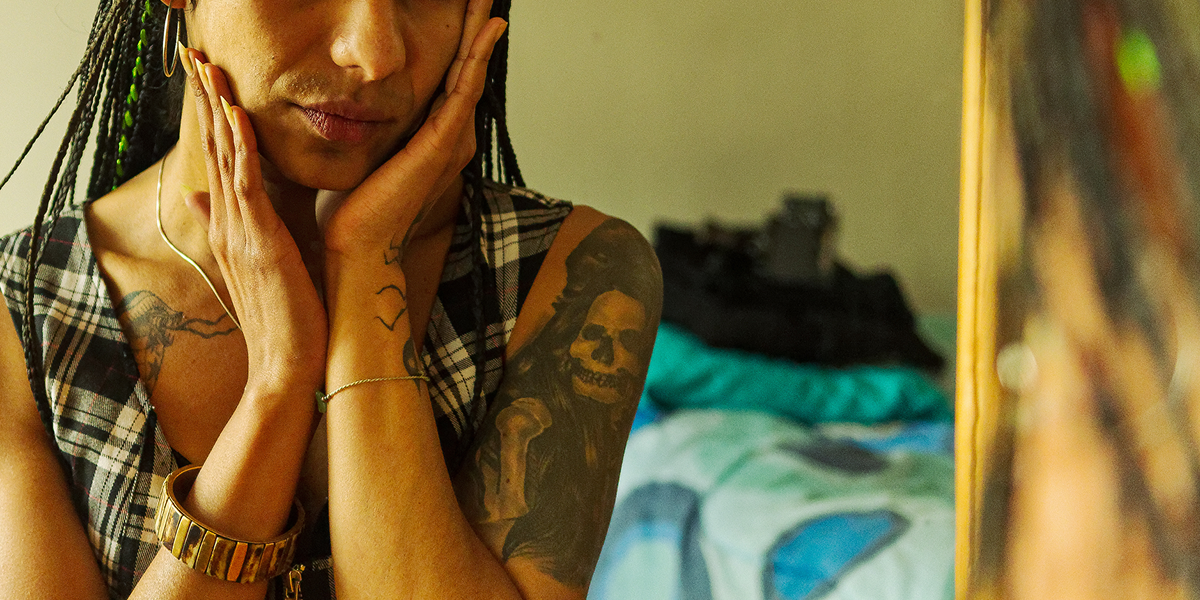No one likes to hear about cancer. And for queer people, sexual health can be a hard topic to navigate. But if you have a cervix, you need to be talking about cervical cancer.
Most people who are born with a vagina/front hole have a cervix. It sits at the top of your vagina/front hole and connects it to the uterus. I once heard someone describe it as feeling like the tip of your nose with a dimple in the middle — weird, but okay. If you’re interested in seeing some real photos of cervixes, you can browse the Beautiful Cervix Project!
Cervical cancer is a type of cancer that originates in the cervix.
Cervical cancer is preventable!
The vaccines Gardasil and Cervarix can prevent most cases of HPV, the virus that causes 91% of cervical cancer cases. And a test called a Pap smear can detect abnormal cells long before they become cervical cancer.
When you get a Pap smear, a healthcare provider uses a swab that looks like a small mascara wand to collect some cells from your cervix (here’s a helpful diagram). Pap smears themselves aren’t generally painful, but they do require the use of a speculum to hold the vagina/front hole open, which can be uncomfortable. Pap smears can catch potential cervical cancer cases before they have a chance to develop. If the test discovers precancerous cells, those can be removed through fairly simple procedures in a doctor’s office or clinic. So, when it comes to cervical cancer, prevention is key.
Everyone with a cervix can start getting Pap smears starting at age 21. From ages 21-29, the American College of Obstetricians and Gynecologists (ACOG) recommends a Pap smear every three years. (If you get an abnormal result — meaning the test found possibly precancerous cells — your doctor may recommend that you get Pap smears more often.)
Starting at age 30, you can keep getting Pap smears every three years, or you can get tested for HPV, with or without a Pap smear, every five years. (An HPV test still involves a pelvic exam and swabbing of the cervix — they just run a different test with the swab.)
Vaccines against HPV are recommended for everyone, regardless of sex assigned at birth or gender, starting at age 11. They’re most effective when people get them before becoming sexually active, but any vaccine is better than no vaccine. If you weren’t vaccinated when you were younger, the ACOG guidelines say you have until you’re 26 to catch up. After that, you and your doctor can decide if it makes sense for you to get vaccinated.
Queer people have higher rates of cervical cancer
It probably won’t come as a surprise to know that national surveys and cancer registries aren’t great about asking people about their sexual orientation and gender identity. This means that we don’t know a whole lot about queer people’s experiences with cervical cancer. The data we do have, though, show that lesbian and bisexual cisgender women in the US have higher rates of cervical cancer compared to straight women.
The differences are shocking, actually: while 14% of all adult women in the US who get cancer get cervical cancer, 17% of lesbian women and 41% of bisexual women do. Lesbian and bisexual women also have worse long-term health after surviving cervical cancer. [Editor’s note 3/14/22: Originally this paragraph stated “while 14% of all adult women in the US get cervical cancer, 17% of lesbian women and 41% of bisexual women do;” that is incorrect, and we have since corrected that sentence to reflect the accurate statistic.]
We don’t really know anything about how many nonbinary folks and trans men get cervical cancer. But these groups tend to have higher rates of other negative health conditions, so the same trend may exist for cervical cancer, too.
Why are there such big differences in cervical cancer rates?
Some of it could be due to behavior. HPV, the cause of most cervical cancer cases, is spread through sex. Bisexual cisgender women are more likely to have penis-in-vagina sex without a condom compared to straight women, so they’re more likely to be exposed to HPV. Cervical cancer is also linked with smoking, and queer women are more likely to smoke than straight women.
But behavior differences don’t tell the whole story. Since vaccination and regular Pap smears are key in preventing cervical cancer, we also have to understand queer people’s access to those services.
Studies overwhelmingly show that queer cisgender women, nonbinary folks AFAB, and trans men are much less likely to get regular Pap smears than straight cisgender people. The findings are less conclusive about HPV vaccination, but one national study found that, among cisgender women, Black lesbians had the lowest vaccination rates of any group, followed by white lesbians and Black bisexual women.
Why are queer people less likely to get HPV vaccines and Pap smears?
It’s not because we’re less conscientious or motivated about maintaining good health. Queer people face a lot of barriers to good healthcare, and cervical cancer prevention is no different.
For starters, queer people tend to be less likely than straight cisgender people to have health insurance. Also, not every state has laws or policies guaranteeing equal access to care for queer populations. Queer people are less likely than straight cisgender people to get regular checkups or have a personal doctor. We’re also much more likely to avoid or put off care because of the cost.
Other barriers have to do with the way queer people are treated in healthcare settings. Healthcare providers may be outright discriminatory, use disrespectful language, fail to acknowledge our queerness, or perpetrate other microaggressions against us. And queer people often have to educate their providers about their healthcare needs. Queer people of color are even more likely to face unfair treatment in healthcare.
When it comes to cervical cancer specifically, many healthcare providers are misinformed. Providers may believe queer people don’t need cervical cancer screening, and they’re much less likely to refer queer patients for Pap smears. Some doctors actually tell their queer patients that they don’t need Pap smears. HPV vaccine marketing and even well-meaning educational organizations may emphasize cervical cancer prevention for straight cisgender women, leaving nonbinary folks AFAB and trans men unaware that they even need HPV vaccination or Pap smears.
So what’s a queer with a cervix to do?
First, find a doctor (or nurse practitioner, physician’s assistant, etc.) and get a checkup. Then keep getting checkups — visit your healthcare provider for a well-patient visit every year. Having a trusting relationship and good communication with a healthcare provider who knows you is an important aspect of getting quality care.
There are resources and databases online that can help you find a queer-affirming provider. Planned Parenthood and other free or sliding-scale clinics can be an option if you don’t have health insurance or can’t afford copays.
If the first doctor you go to is a dud, don’t give up. It can be disheartening to deal with awkwardness (at best) or discrimination (at worst). But not every experience will be like this, so don’t take one bad experience (or two, or three) to mean that quality healthcare isn’t in the cards for you.
Second, if it’s safe to do so, come out to your doctor. This opens the door for conversations about sexual and relationship health. I know it can be hard, and your doctor may handle the information awkwardly, but it’s an important step in establishing that trusting, communicative relationship.
Third, show up to your appointment with questions. It can be helpful to write down your questions beforehand. Think about what you want to know. Are you due for a Pap smear? Are you up-to-date on your vaccinations? Should you get screened for STIs? Literally write your questions down on a piece of paper or a note in your phone. Then, when your doctor answers them, take notes. Repeat the information back to your doctor to make sure you understand. You deserve to take up space at the doctor’s office and to make use of your doctor’s time.
TL;DR:
Queer people face higher rates of cervical cancer and lower rates of vaccination and screening, and we deserve better. Armed with the facts, you can advocate for your wellbeing and get the preventive care you deserve.








Comments
I (cis asexual lesbian) was told at my first smear (UK) by the nurse that I did not need the test because I had never been with a man. (My risk is way low because I’d never been with anyone, but she didn’t know that, and I didn’t know my risk level was low). Healthcare providers need to be educated.
Going to the gyno as an asexual is such a time!!! The providers have been kind to me, but never seem to know how to react? It makes me worried.
Correct me if I am wrong, but I think there is a misinterpretation of the data cited from the study. You write that “while 14% of all adult women in the US get cervical cancer, 17% of lesbian women and 41% of bisexual women do”. In the study you linked, in table 2 it says that 7,71% of heterosexual, 8,59% of lesbian and 6,04% of bisexual adult women report that they had cancer in their adulthood. Of those women, 14% of heterosexual, 17 % of lesbian and 41% of bisexual women report cervical cancer. That’s a pretty big difference.
thank you for pointing out! it’s huge difference indeed
Yes, came here to say that this misinterpretation of the data was huge—the table in the source was unwieldy but shows different proportions of cancer type by sexuality, rather than percentages of the entire population being diagnosed.
It’s also important to note that the heterosexual cancer population was 7000 women while lesbian and bisexual were <100 each, so despite the analysis applied I’m suspicious of how much weight there truly is.
It remains true that for every single diagnosis, the earlier the better, and for all of us, engaging in health-promoting, anti-cancer behaviors is a good idea. The amount of substance use, especially alcohol and tobacco, in the queer community is a huge worry.
Love reading this article as a queer who works at an OBGYN! Before working where I worked, I had absolutely no idea how often I needed to get a Pap smear or anything about cervical cancer– I think I was also told that I didn’t need to get a pap unless I was sexually active by a previous provider. Now, I love being able to schedule appointments for LGBTQ clients and help them navigate their care (in my limited admin way)– truly warms my heart.
Thank you for all of this important information!
Also: “Bisexual cisgender women are more likely to have penis-in-vagina sex without a condom compared to straight women, so they’re more likely to be exposed to HPV.” This is surprising to me because I tend to think that bi/queer women are more likely to have safer sex than straight cis women. Is there a source for this? Or can you say more about it?
Yes! Often, bisexual folks of all genders have poorer health outcomes than both straight and gay/lesbian people. Some studies have suggested that this has something to do with the additional discrimination and marginalization bi people face from being rejected by both straight and gay/lesbian communities. Decreased frequency of condom use may be associated with fear of rejection, reduced access to health information, and other things bisexual folks may be more likely to face. Here’s a study of sexual behaviors, including condom use, among female college students that found that bisexual women were less likely than straight women to use condoms for vaginal intercourse (but more likely for anal intercourse, interestingly): https://pubmed.ncbi.nlm.nih.gov/24183409/
I’m trans masc but we gotta come up with a better term than “front hole.” Ugh.
There’s a fantastic research publication that makes me vaguely sad I’ll never write something with this good of a title:
“From “shark-week” to “mangina”: Preferred words reported for sexual and reproductive health anatomy by transgender, non-binary, and gender-expansive people.”
Sadly, it’s behind a paywall like most academic lit, but you can Google a short summary!
Something that was recommended to me about accessing academic papers behind a paywall – often, the money just goes to the journal or publication platform itself, so the contributing authors either don’t see much of that money, or get nothing at all back for their contribution. If you can find the author’s name and are able to contact them directly via social media or other avenues, and express an interest in reading their paper and enquire if you could receive a copy, quite a high number of them are delighted that you’re interested and are happy to share their knowledge. It’s not foolproof, but worth a shot!
you can also request to get copies of academic articles (and other stuff your library doesn’t have) via interlibrary loan at your public library! i do it through my local public library all the time and often get digital articles emailed to me within a few days. I also use it to get copies of books or other things that my library doesn’t have. ILL is like my secret data weapon.
I found the ressource to be accessible here https://www.ncbi.nlm.nih.gov/pmc/articles/PMC8665782/
33% of respondents use “front hole”!! This study slaps tho. Adjacent question, does anybody use “dickclit”? I don’t see any mention of it in this study which surprises me!
I can send you that full article! DM me your email on twitter @mcmontgomery
Yes please!! “front hole” always makes me cringe uglily!
The beautiful cervix project is fascinating! I learned so much from going through their gallery.
For those who *do* find pap smears painful, whether due to vaginismus (shoutout to that article about it today) or other issues, your doctor can help; ask them to use the smallest speculum, use lidocaine to lessen the sensation, maybe provide anti-anxiety medication to take before your exam. I was lucky enough to have a doctor (nurse practitioner, specifically) who actually offered these to me, I wouldn’t have known to ask otherwise. It’s still a rough experience but not as bad as it could be. So I hope others who need help can also get it!
True! And ask them to warm up a (metal) speculum, if they don’t do that already, makes a difference in comfort.
totally. my nurse midwife also said she could have me use the speculum on myself since for me it is the act of another person doing it to me that sends me into dissociation and clenching.
I am glad that you found someone who understood what was going on and offered different solutions so that ultimately you could get the care you need.
Just a warning. Not everyone has vaginismus. Sometimes doctors perform badly. One doctor was moving around a lot down there and made me bleed. While I was still on the examing table, I pointed out the small pool of blood.
They said it was normal, but I quickly replied that in my years of going to the ob GYN, I never bled.
Long story short some practitioners try to cover up their misdeeds as normal or somehow you’re at fault.
Just want to say that I absolutely love planned parenthood!
I always feel respected and valued when I’m there
Last time I went I was amazed when the gynecologist even had experience with trans masc people and looking for vaginal thinning!
Why is age 26 the cutoff point for universally recommended HPV vaccination?
Because they assume people have been sexually active by then?
I don’t have the research top of mind right now, but I think you can get one at any age, but they might be less effective.
Another factor I think is that queer women, especially bisexual women, and trans folks are also experiencing sexual assault at higher rates than the cis hets and this can lead to avoidance of paps and really negative ob/gyn experiences
“The differences are shocking, actually: while 14% of all adult women in the US get cervical cancer, 17% of lesbian women and 41% of bisexual women do.”
I found this shockingly high, too, so I dug into the hyperlink at “differences.” I have to conclude you got this by looking at Table 2, row “cervical” under the subheading “type of cancer”, where the row reads 14.00 (0.59) 16.52 (5.01) 41.24 (8.33) for the prevalences/SE for straight/lesbian/bi women, respectively. The reason “type of cancer” appears in that chart is that this is subgroup data for the women in the sample who *have* been diagnosed with cancer, who are only about a tenth of the total number of women in the study. That should make it closer to 4 or 5% of bisexual women who have had cervical cancer.
While it’s still concerning that bisexual women with cancer are so much likelier to have had cervical than other sorts of cancer, I’m disappointed that Autostraddle published a claim that 41% of bisexual women get cervical cancer based on misreading data. For context, the National Cancer Institute website* thinks about 40% of Americans will eventually get cancer of *any* sort, and there are many types of cancer, so a claim that 40% of any group will get a specific cancer deserves a great deal of scrutiny before republishing.
*https://www.cancer.gov/about-cancer/understanding/statistics#:~:text=Approximately%2039.5%25%20of%20men%20and,will%20die%20of%20the%20disease.
You are so right. Another paper I used also mis-cited these stats, so good catch, thank you! I’ve asked to revise that sentence to say, “The differences are shocking, actually: while 14% of all adult women in the US who get cancer get cervical cancer, 17% of lesbian women and 41% of bisexual women do. Lesbian and bisexual women also have worse long-term health after surviving cervical cancer.”
Hi Madeline, thanks for this important article! I came here to say the same thing, and the article (as of 10:30 AM on 3/14/22) still says “The differences are shocking, actually: while 14% of all adult women in the US get cervical cancer, 17% of lesbian women and 41% of bisexual women do.”
Just wanted to flag this again.
Thanks for the heads up! I submitted the revision, but I can’t actually do it myself from the back end!
thanks for this important article, madeline, and for staying on top of the comments and submitting the revision. it’s corrected now!
thank you for pointing this out! it’s been corrected.
This was really helpful! I have had a lot of bad experiences when getting Pap smears due to homophobia AND weight stigma and a history of sexual trauma. I have to wonder how much the latter two contribute to poorer outcomes in queer people with cervixes since I believe we experience sexual trauma at higher rates and also are in larger bodies. (NB I do not mean worse outcomes due to larger body size — popular belief about that us based on dubious research funded by companies who profit off selling weight loss — specifically I am talking about how weight stigma both external and internal impacts health in profound ways. I will not bother arguing this point with anyone who wants to bring up tired fatphobic talking points that have been debunked brilliantly and thoroughly already.)
I’m very overdue to find a new OB-GYN and haven’t been able to muster up the necessary fortitude to subject myself to what is, at best, an exhausting process even when I find a doctor who is queer and fat positive. Reading this article definitely gave me a little more energy around this dreaded task!
Agreed! Weight stigma is such a huge barrier to preventative health. Larger bodies are healthy bodies too. I’m so sick of health professionals micro-aggressions or outright comments on “maybe lose a few kg’s as well”. Dude, I was here for a prescription, not a commentary on my perceived size.
Otro factor que creo es que las mujeres queer, especialmente las mujeres bisexuales y las personas trans también están experimentando agresiones sexuales a tasas más altas que las cis y esto puede llevar a evitar los exámenes de Papanicolaou y experiencias realmente negativas de obstetricia y ginecología.
Antes de trabajar donde trabajaba, no tenía ni idea de con qué frecuencia necesitaba hacerme una prueba de Papanicolaou ni nada sobre el cáncer de cuello uterino. Creo que también me dijeron que no necesitaba hacerme una prueba de Papanicolaou a menos que fuera sexualmente activa.
This is a very important piece. I had a conversation just yesterday with two friends where we learned that all three of us have had abnormal paps and irregular cells. The Beautiful Cervix page is very helpful too.
Thank you for such an important piece.
My experiences getting Pap smears have been fairly awful, even when I went to a supportive doctor.
I once had the nurse setting everything up question me at length as to why I needed a Pap smear [as my records state M]. I was already on edge, nervous, struggling with dysphoria and trauma, so this was awful while I was so vulnerable.
Then the lab never processed or looked at my pap (also likely due to my records saying M, I’ve heard of other trans folx reporting this). The lab did manage to process all of my other samples and blood tests sent together. So I had to have another pap but I requested a different nurse. Apparently they trained one doctor at the facility to work with trans patients & the appointment schedulers were trained, but not the nurses & other staff.
After a later pap, where I had to wait while the smallest speculum was located, the lab left a comment on my results for my doctor that in future she should not use any type of medical lube, lidocaine, or anything else to avoid “contamination” of the results. She said it was fine, but it really bothered me that the lab at a top research hospital felt it couldn’t process samples in which help was required for the speculum and I wondered if it was because of the M again.
Like others, I’ve received comments about not needing tests when dating queer and trans folx (also these questions frequently led to me being asked about genitals in awkward ways in order to discover if I was actually “at risk”). Finding a queer and trans educated doctor, practice, and lab is so important, especially with trauma and dysphoria.